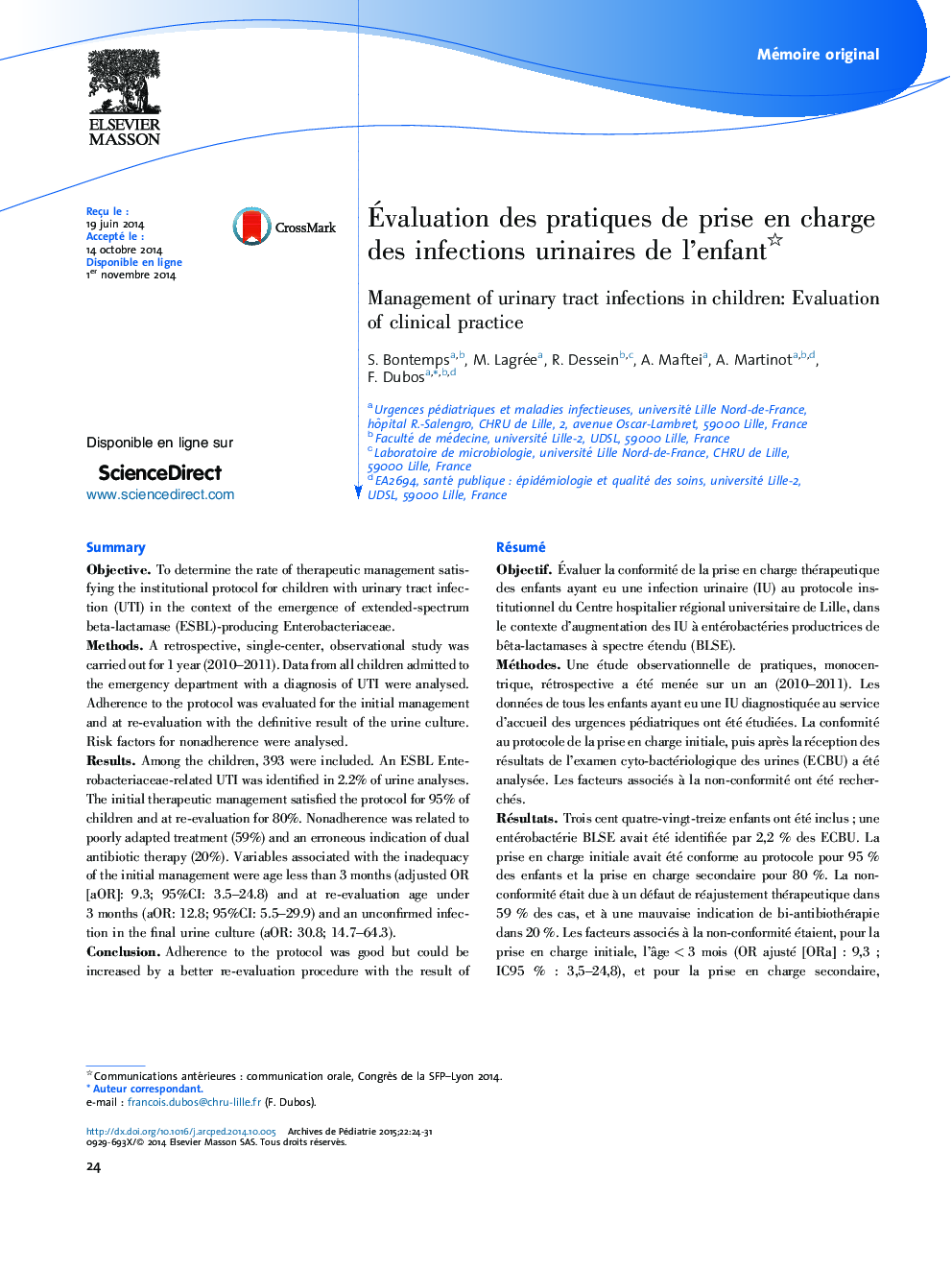| Article ID | Journal | Published Year | Pages | File Type |
|---|---|---|---|---|
| 4146413 | Archives de Pédiatrie | 2015 | 8 Pages |
RésuméObjectifÉvaluer la conformité de la prise en charge thérapeutique des enfants ayant eu une infection urinaire (IU) au protocole institutionnel du Centre hospitalier régional universitaire de Lille, dans le contexte d’augmentation des IU à entérobactéries productrices de bêta-lactamases à spectre étendu (BLSE).MéthodesUne étude observationnelle de pratiques, monocentrique, rétrospective a été menée sur un an (2010–2011). Les données de tous les enfants ayant eu une IU diagnostiquée au service d’accueil des urgences pédiatriques ont été étudiées. La conformité au protocole de la prise en charge initiale, puis après la réception des résultats de l’examen cyto-bactériologique des urines (ECBU) a été analysée. Les facteurs associés à la non-conformité ont été recherchés.RésultatsTrois cent quatre-vingt-treize enfants ont été inclus ; une entérobactérie BLSE avait été identifiée par 2,2 % des ECBU. La prise en charge initiale avait été conforme au protocole pour 95 % des enfants et la prise en charge secondaire pour 80 %. La non-conformité était due à un défaut de réajustement thérapeutique dans 59 % des cas, et à une mauvaise indication de bi-antibiothérapie dans 20 %. Les facteurs associés à la non-conformité étaient, pour la prise en charge initiale, l’âge < 3 mois (OR ajusté [ORa] : 9,3 ; IC95 % : 3,5–24,8), et pour la prise en charge secondaire, l’âge < 3 mois (ORa : 12,8 ; IC95 % : 5,5–29,9) et un ECBU négatif (ORa : 30,8 ; 14,7–64,3).ConclusionLa conformité au protocole avait globalement été bonne mais pourrait être optimisée en améliorant la procédure de réévaluation après réception de l’ECBU. Les IU à entérobactérie BLSE, encore rares dans ce centre, n’avaient pas été source de non-conformité.
SummaryObjectiveTo determine the rate of therapeutic management satisfying the institutional protocol for children with urinary tract infection (UTI) in the context of the emergence of extended-spectrum beta-lactamase (ESBL)-producing Enterobacteriaceae.MethodsA retrospective, single-center, observational study was carried out for 1 year (2010–2011). Data from all children admitted to the emergency department with a diagnosis of UTI were analysed. Adherence to the protocol was evaluated for the initial management and at re-evaluation with the definitive result of the urine culture. Risk factors for nonadherence were analysed.ResultsAmong the children, 393 were included. An ESBL Enterobacteriaceae-related UTI was identified in 2.2% of urine analyses. The initial therapeutic management satisfied the protocol for 95% of children and at re-evaluation for 80%. Nonadherence was related to poorly adapted treatment (59%) and an erroneous indication of dual antibiotic therapy (20%). Variables associated with the inadequacy of the initial management were age less than 3 months (adjusted OR [aOR]: 9.3; 95%CI: 3.5–24.8) and at re-evaluation age under 3 months (aOR: 12.8; 95%CI: 5.5–29.9) and an unconfirmed infection in the final urine culture (aOR: 30.8; 14.7–64.3).ConclusionAdherence to the protocol was good but could be increased by a better re-evaluation procedure with the result of the urine culture. ESBL Enterobacteriaceae-related UTIs were still rare enough to influence the efficacy of management.
